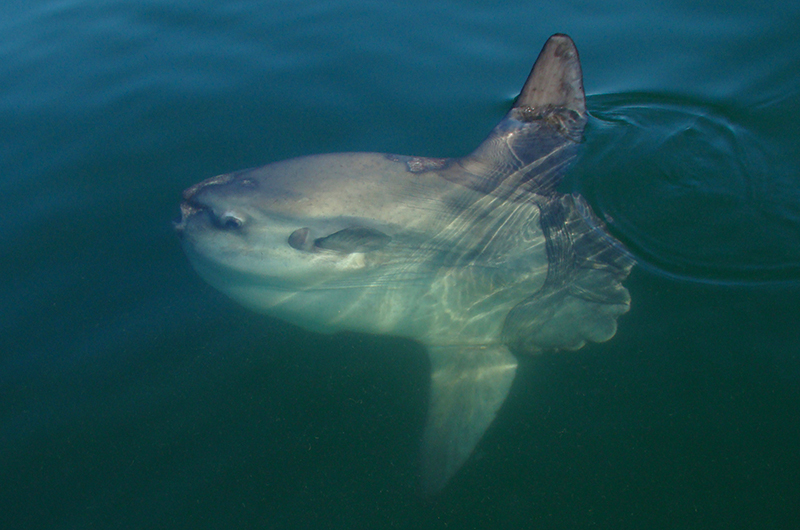In early June, a large black dorsal fin cut across the placid surface of Lake Tashmoo. No need to cue the Jaws soundtrack.
The fin belonged to an ocean sunfish, a creature quite different in temperament and dental work from the fish that terrified the fictional town of Amity and put Martha’s Vineyard on the celluloid map.
David Stanwood of West Tisbury, piano tuner and inventor, had moved a boat to a mooring late that Saturday afternoon. He’d often seen sunfish while sailing in the ocean. But it was a surprise to see one in Tashmoo, a 270-acre saltwater pond connected to Vineyard Sound by a narrow channel.
“I looked up, and there it was,” he said. “They belong in open water.”
Known by its scientific name, Mola mola, the oddly shaped sunfish – it appears to be all head – feeds on jellyfish, small fish, squid, and crustaceans. The world’s heaviest bony fish, adults weigh between 500 and 2,000 pounds. A record mola caught in Japan weighed 5,071 pounds.
Their name comes from their habit of laying on their sides basking in the sun. According to a map on oceansunfish.org, they are not uncommon in New England waters in the summer, where they often spur panicked shark-sighting calls to local authorities.
Stanwood reported his sighting to the New England Basking Shark & Ocean Sunfish Project (nebshark.org), an all-volunteer nonprofit based in Southeastern Massachusetts dedicated to learning more about these large pelagic fish.
Project founder Carol “Krill” Carson said it was the first sighting of the season and earlier than in past years – a fact she attributed to warmer than usual temperatures.
The following day, charter captain Lynne Fraker watched from her classic wooden sloop Ena as the sunfish breached, jumping halfway out of the water. “There was a big splash, and it made quite a sound,” Fraker said. “It was quite exciting to see it do that.”
Ocean sunfish may jump up to ten feet in the air to dislodge the many parasites embedded in their skin. Concern among the Tashmoo regulars grew that the sunfish would not find its way out of the pond.
Two days later, while working for the Tisbury shellfish department, I came across the sunfish on its side in a few feet of water on a sandflat on the west side of the pond. Concerned the fish might be stranded, I put on waders and attempted to push it into deeper water. The sunfish moved slowly, its eye focused on me.
“What was it thinking?” I considered its ability to breach. Crushed by an ocean sunfish was not a welcome epitaph.
Curiously, after I had pushed it off the flat, the sunfish circled back to the shallow water again. Carson said people sometimes assume the sunfish is sick or injured, but the fact that it returned is not unusual behavior for one that is disorientated and panicked. In fact, a sunfish in shallow water becomes docile, and that is the optimum time to try and secure it so it can be moved, she said.
I pushed the fish off again into deeper water and hoped for the best. I was resigned to let nature take its course.
Luckily for the sunfish, farmer Liz Packer, owner of SBS in Vineyard Haven, and her daughter Lucy went for a bike ride in the late afternoon along the dirt road that leads to the Tashmoo channel entrance. They spotted a pair of large fins “flopping around” on the west sand flat that flanks the channel entrance.
The sunfish lay on its side in a muddy depression it had created by its struggles in the dropping tide.
“It’s looking at you, and we knew we couldn’t just leave it there,” Packer said.
She began calling for reinforcements while her daughter rode back to the farm to fetch their waders. Lobsterman Jason Gale said his fourteen-year-old son Tegan and friend Luke Silvia were on the pond in a skiff. The boys quickly arrived and got as close as they could in the shallow water.
“We were able to rock it – I mean the thing probably weighed four, five hundred pounds – out of the divot into a little deeper water, and Tegan had a line, and we made a little bridle,” Packer said.
As the rescuers towed the fish to deeper water, it became more animated. “The color all around its eye turned much darker, and it started to wiggle and flap its fins,” she said.
Once at the channel entrance jetty and with the tide flowing out of the pond, she said, the sunfish “decided it was going, so we just let it go.”
The sunfish dove and disappeared into Vineyard Sound.
“They did such a great job,” Carson said of the rescue. “It’s nice to have so many people so concerned about these animals and help out, because it was a healthy fish in the wrong place at the wrong time.”




 1 comment
1 comment
Comments (1)